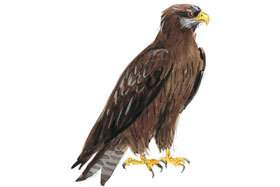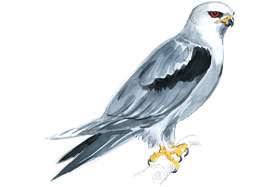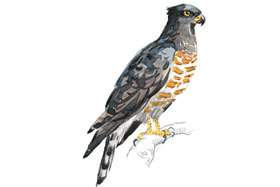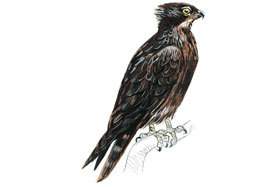
A big birding debate has been the reclassification of the Yellow-billed Kite (Milvus migrans parasitus) to that of the Black Kite (Milvus migrans). To all appearances the birds are markedly different, but it appears that their genetic make-up does not warrant separate classifications.
This is a hard one for Kruger birders to accept, particularly as the 'old' Yellow-billed Kite is a common summer visitor, while the 'old' Black Kite is a Eurasian vagant, rarely seen in the Park.
There has been an understandable outcry and it would seem that this debate is far from over. For the sake of clarity we have decided to differentiate between the two kites, and while not disputing their genetic similarity, the entrenched common names of Yellow-billed and Black Kites will remain the same.
Yellow-billed Kite (Milvus migrans)
Afrikaans: Geelbekwou
The Yellow-billed Kite is one of the first migrants in Kruger, often arriving in August before the start of the rainy season. It departs after the last summer rains, which are usually in March. It is graceful in flight, and capable of bursts of surprising speed.
Its distinctive V-shaped tail gives it high-precision manoeuvrability when chasing prey - it can catch insects in its talons in mid-flight. There are stories from west African markets of the Yellow-billed Kite's ability to seize food from a pot being carried on a woman's head without her being aware of the theft. It is unperturbed by human activity and often nests at water sources near rest camps.
Like many other raptors, the Yellow-billed Kite relies on termites as a major food source. Scores of them will gather to feed, along with species such as Lesser Spotted and Steppe Eagles, when the insects emerge from the ground. The kite grabs the termites with its talons and eats them in flight. It is an opportunistic feeder with a diverse diet ranging from puffadders to fish.
It has also been seen gathering in large numbers in November and December during impala lambing season. The birds circle above the impala herds and descend to pick up the afterbirth rather than attack the newborn lambs.
If the Yellow-billed Kite was human it would have a long criminal record! It is a daring avian highway robber that steals food from other birds. Peter Steyn relates several incidents of having witnessed this - once two Yellow-billed Kites collaboratively attacked an African Fish-Eagle, forcing this big raptor to abandon its meal, while on another occasion they took a 15-cm barbel out of the beak of a Woolly-necked Stork.
It is also feeds on carrion, and although it arrives early at a carcass, it depends on other birds with stronger beaks to rip open the skin before it can eat. Perhaps for this reason it has the reputation of being a roadkill raptor of note. Many Yellow-billed Kites become roadkill themselves - vehicles are a leading cause of death. The oldest, ringed Yellow-billed Kite was 23 years old.
Yellow-billed Kite Characteristics
Adult Height
55cm
Weight
450g - 1kg
Wingspan
1.6-1.8m
Dark brown bird with yellow beak and distinctive V-shaped tail.Migrant
Prey
Opportunistic hunter, pirate and scavenger with a broad diet; particularly fond of termites and other insects but eats whatever it can find - rats, birds, snakes, fish, frogs, roadkill and carrion.
Where best to find them
Throughout the Park in summer; large numbers in the central Park.
Black-shouldered Kite (Elanus caeruleus)
Afrikaans: Blouvalk
The Black-shouldered Kite is a small, graceful raptor and the most voracious eater in the raptor family. It needs to consume up to 25% of its body mass every day - that is the equivalent of about two mice. This means each bird probably kills around 700 mouse-sized animals a year.
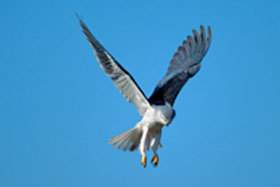 Now, Roberts VII estimates there are about 100 000 Black-shouldered Kites in southern Africa, so if we assume each bird takes two mice a day, that adds up to about 70 million mice being consumed by this species alone every year. Think of how many mice there are out there that are not being eaten!
Now, Roberts VII estimates there are about 100 000 Black-shouldered Kites in southern Africa, so if we assume each bird takes two mice a day, that adds up to about 70 million mice being consumed by this species alone every year. Think of how many mice there are out there that are not being eaten!
Although the Black-shouldered Kite is perhaps the most common South African bird of prey, it does not always have much of a presence in Kruger. It prefers the highveld grasslands probably because prey is easier to see than in the more densely wooded lowveld.
Its appearance in the Park is linked to increases in the local rodent population. Black-shouldered Kites are solitary hunters by day, yet often roost communally at night. They usually spend between four and 10 hours a day in flight, but also often hunt from a perch.
One of their characteristics is to hover (air-perch) in one place above the ground searching for prey. Black-shouldered Kites range widely. The longest range so far recorded was that of a bird ringed in the former Transvaal and recovered in northern Mozambique, 915km away. Another bird ringed at the same time was recovered in the opposite direction - in the Cape, 645km away.
Black-shouldered Kite Characteristics
Adult Height
30cm
Weight
240-260g
Wingspan
84cm
Grey and white raptor with black shoulder pads and ruby-red eyes; conspicuous in flight, often hovering 10m above ground looking for prey.Resident
Prey
Over eighty percent of its diet consists of mice and other similar sized rodents; also preys on doves, lizards and insects.
Where best to find them
Mostly in the open grasslands of eastern Kruger and in the west around Orpen.
African Cuckoo Hawk (Aviceda cuculoides)
Afrikaans: Koekoekvalk
The African Cuckoo Hawk is an unobtrusive hunter, avoiding open areas and sticking to the fringes of dense woodlands and gallery forests. It flies leisurely from tree to tree and then perches, silent and motionless, for long periods of time under thick cover, scouring the ground for prey. One of its favourite foods is the chameleon but it has a varied diet.
It seems to be restricted mostly to the north and south-west, but is also often seen in the thicker terminalia woodlands around Pretoriuskop. It appears to disperse over large areas during winter. It has a plaintive, three-note whistle that sounds like tickey to tou . Like many of the smaller raptors it is extremely skillful in negotiating the dense forest canopy in its search for prey.
African Cuckoo Hawk Characteristics
Adult Height
40cm
Weight
250g
Wingspan
90cm
Grey, crested head; grey bib and rufous, barred, white chest with dark upperwingsResident
Prey
Mostly grasshoppers and other large insects; sometimes lizards; also likes chameleons and small snakes.
Where best to find them
Most records are from the Luvuvhu, Limpopo and Sabie Rivers, also in south-western foothills around Pretoriuskop.
Bat Hawk Characteristics
Adult Height
40cm
Weight
250g
Wingspan
1.1m
Dark brown plumage; yellow eye and dark beak; long pointed wings and square tipped tail; whitish feet.Resident
Prey
Mostly bats and small birds like swifts and swallows; also small reptiles.
Where best to find them
Most common in the north, particularly around Pafuri, Punda and Letaba where there are large resident bat populations.
Bat Hawk (Macheiramphus alcinus)
Afrikaans: Vlermuisvalk
There are very localised populations of Bat Hawk in Kruger - mostly in the north - so it is not often seen. It also may be an altitudinal migrant coming down to the lowveld from the escarpment in winter. As its name suggests, it lives mostly on bats so it is found where they are - moist woodland in river valleys, around Baobabs or next to cliffs.
The Bat Hawk sleeps during the day - when bats sleep - and becomes a very active hunter at dusk when bats emerge. Although it has an almost lazy flying style, it is a skillful hunter determined in its pursuit of prey. Bat Hawks are capable of eating a bat every three minutes and will often consume their entire daily food requirement within 20 minutes to half an hour.

